DeepseekerADS
Gold Member
- Joined
- Mar 3, 2013
- Messages
- 14,880
- Reaction score
- 21,745
- Golden Thread
- 0
- Location
- SW, VA - Bull Mountain
- Detector(s) used
- CTX, Excal II, EQ800, Fisher 1260X, Tesoro Royal Sabre, Tejon, Garrett ADSIII, Carrot, Stealth 920iX, Keene A52
- Primary Interest:
- Other
- #1
Thread Owner
An archaeologist visited an Irish castle for a survey. He never expected to find a 17th century party stash. - The Washington Post
By Sarah Larimer November 13 at 1:40 PM
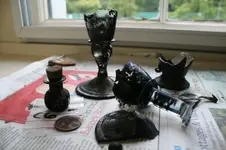
These drinking glasses are stained black from the deposit in which they were preserved. (Alva Mac Gowan/Courtesy of Archaeology Plan)
Antoine Giacometti was just there for an elevator.
Giacometti, the archaeological director for the organization Archaeology Plan, showed up to survey Rathfarnham Castle in Ireland in the summer. He knew the castle contained some artifacts — it is a historic building, after all — but the tower that was selected for the elevator shaft seemed … uninteresting, in preliminary investigations.
Then, the tower’s floor was pulled up, exposing a pit, and Giacometti stuck his hand in the muck.
He pulled up a piece of gold jewelry, and Giacometti and the builder he was with realized there were more items down there, too.
“At that point,” Giacometti told The Post in a phone interview, “I then had to turn around and say ‘Look, your lift shaft is going to be delayed.’”
Rathfarnham Castle was built in South Dublin in 1583 and has been home to several families, according to Live Science. The items discovered in the pit were from 1650 to 1700, when it was probably sealed, which helped preserve them quite well.
The haul included:
• Shoes (lots and lots of shoes)
• Porcelain plates
• Tea cups
• An armor breastplate
• A red substance, that might have been used to redden the cheeks and lips of women, like 17th century lip stain and blush
“Everything was pretty much preserved perfectly, like the day it was placed in there,” Giacometti said.
Here’s the backstory on the castle, according to Live Science:
Perhaps the castle’s residents hid the items there during a raid, or maybe the knickknacks were placed there for washing and were never reclaimed. Or, a person could have dumped them into the pit, for lack of a better storage place, Giacometti said.
At any rate, the artifacts likely belonged to the household of Lord Adam Loftus (1625-1691), a descendant of the original Archbishop Adam Loftus, who built the castle, Giacometti said. The lord worked with King Charles II and King William of Orange, and oversaw Irish state finances during a time of great tension between Catholic Ireland and Protestant England.
Loftus lived at the castle with his wife Lucy, son James, who died young, and daughter Lucia, who married Philip Wharton the infamous “Rake of Rathfarnham.” The rake, a notorious rascal, scammed his way into prestigious positions, married multiple times (typically with bad results), invested heavily in economic bubbles and died nearly penniless, Giacometti said.
Part of what makes these artifacts cool, Giacometti told The Post, is that most were used for entertaining. His favorite is a bone marrow spoon, made of ebony. He’s never seen one like it before. (I didn’t even know that rich people used things like bone marrow spoons!)
“They certainly did,” Giacometti said, when asked if the Loftus family knew how to party. “There’s no doubt.”
And the shoes! Can we talk about the shoes? They found shoes for both women and men — indoor shoes, outdoor shoes, delicate shoes, shoes with heels.
In those days, Giacometti said, there were no left and right shoes. There were just shoes, and people rotated them around, so the shoes wouldn’t bend one direction or the other. Every day is a new adventure, I guess.
Check out pictures of the artifacts below. Giacometti says the items would likely be available for the public to view in a few years. And in case you were wondering, the elevator is going in the tower anyway; since the pit was already exposed, officials decided they might as well keep going with it.
“Everybody wins,” Giacometti said.
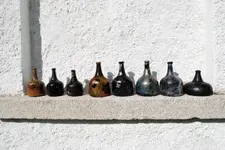
Glass wine and spirit bottles. (Alva Mac Gowan/Courtesy of Archaeology Plan)
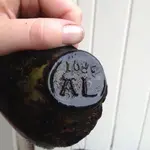
Some of the wine bottles have the seal “AL 1688,” which archaeologists believe means they were made for Lord Adam Loftus’ personal cellar. (Alva Mac Gowan/Courtesy of Archaeology Plan)
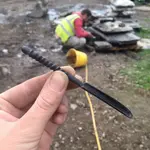
This bone marrow spoon might be made from ebony. (Alva Mac Gowan/Courtesy of Archaeology Plan)
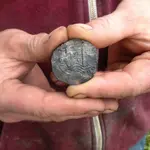
Some coins were also recovered, including this one, which was minted in 1655. (Alva Mac Gowan/Courtesy of Archaeology Plan)
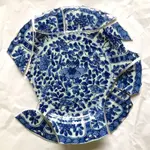
This tea set plate, imported from China, is from the 17th century, when tea drinking had just been introduced in England. (Alva Mac Gowan/Courtesy of Archaeology Plan)
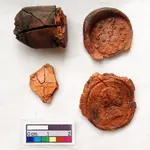
These red wax seals still bear some coats of arms. (Alva Mac Gowan/Courtesy of Archaeology Plan)
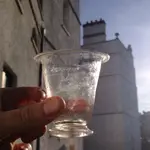
This drinking glass is in pretty good condition, all things considered. (Alva Mac Gowan/Courtesy of Archaeology Plan)
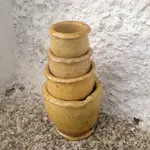
Small jars contained ointments and cosmetics. (Alva Mac Gowan/Courtesy of Archaeology Plan)
By Sarah Larimer November 13 at 1:40 PM

These drinking glasses are stained black from the deposit in which they were preserved. (Alva Mac Gowan/Courtesy of Archaeology Plan)
Antoine Giacometti was just there for an elevator.
Giacometti, the archaeological director for the organization Archaeology Plan, showed up to survey Rathfarnham Castle in Ireland in the summer. He knew the castle contained some artifacts — it is a historic building, after all — but the tower that was selected for the elevator shaft seemed … uninteresting, in preliminary investigations.
Then, the tower’s floor was pulled up, exposing a pit, and Giacometti stuck his hand in the muck.
He pulled up a piece of gold jewelry, and Giacometti and the builder he was with realized there were more items down there, too.
“At that point,” Giacometti told The Post in a phone interview, “I then had to turn around and say ‘Look, your lift shaft is going to be delayed.’”
Rathfarnham Castle was built in South Dublin in 1583 and has been home to several families, according to Live Science. The items discovered in the pit were from 1650 to 1700, when it was probably sealed, which helped preserve them quite well.
The haul included:
• Shoes (lots and lots of shoes)
• Porcelain plates
• Tea cups
• An armor breastplate
• A red substance, that might have been used to redden the cheeks and lips of women, like 17th century lip stain and blush
“Everything was pretty much preserved perfectly, like the day it was placed in there,” Giacometti said.
Here’s the backstory on the castle, according to Live Science:
Perhaps the castle’s residents hid the items there during a raid, or maybe the knickknacks were placed there for washing and were never reclaimed. Or, a person could have dumped them into the pit, for lack of a better storage place, Giacometti said.
At any rate, the artifacts likely belonged to the household of Lord Adam Loftus (1625-1691), a descendant of the original Archbishop Adam Loftus, who built the castle, Giacometti said. The lord worked with King Charles II and King William of Orange, and oversaw Irish state finances during a time of great tension between Catholic Ireland and Protestant England.
Loftus lived at the castle with his wife Lucy, son James, who died young, and daughter Lucia, who married Philip Wharton the infamous “Rake of Rathfarnham.” The rake, a notorious rascal, scammed his way into prestigious positions, married multiple times (typically with bad results), invested heavily in economic bubbles and died nearly penniless, Giacometti said.
Part of what makes these artifacts cool, Giacometti told The Post, is that most were used for entertaining. His favorite is a bone marrow spoon, made of ebony. He’s never seen one like it before. (I didn’t even know that rich people used things like bone marrow spoons!)
“They certainly did,” Giacometti said, when asked if the Loftus family knew how to party. “There’s no doubt.”
And the shoes! Can we talk about the shoes? They found shoes for both women and men — indoor shoes, outdoor shoes, delicate shoes, shoes with heels.
In those days, Giacometti said, there were no left and right shoes. There were just shoes, and people rotated them around, so the shoes wouldn’t bend one direction or the other. Every day is a new adventure, I guess.
Check out pictures of the artifacts below. Giacometti says the items would likely be available for the public to view in a few years. And in case you were wondering, the elevator is going in the tower anyway; since the pit was already exposed, officials decided they might as well keep going with it.
“Everybody wins,” Giacometti said.

Glass wine and spirit bottles. (Alva Mac Gowan/Courtesy of Archaeology Plan)

Some of the wine bottles have the seal “AL 1688,” which archaeologists believe means they were made for Lord Adam Loftus’ personal cellar. (Alva Mac Gowan/Courtesy of Archaeology Plan)

This bone marrow spoon might be made from ebony. (Alva Mac Gowan/Courtesy of Archaeology Plan)

Some coins were also recovered, including this one, which was minted in 1655. (Alva Mac Gowan/Courtesy of Archaeology Plan)

This tea set plate, imported from China, is from the 17th century, when tea drinking had just been introduced in England. (Alva Mac Gowan/Courtesy of Archaeology Plan)

These red wax seals still bear some coats of arms. (Alva Mac Gowan/Courtesy of Archaeology Plan)

This drinking glass is in pretty good condition, all things considered. (Alva Mac Gowan/Courtesy of Archaeology Plan)

Small jars contained ointments and cosmetics. (Alva Mac Gowan/Courtesy of Archaeology Plan)



 Wish I still had my Apple II+, but the X put it to the curb....
Wish I still had my Apple II+, but the X put it to the curb....
